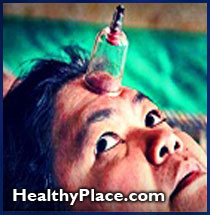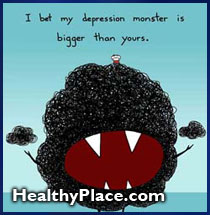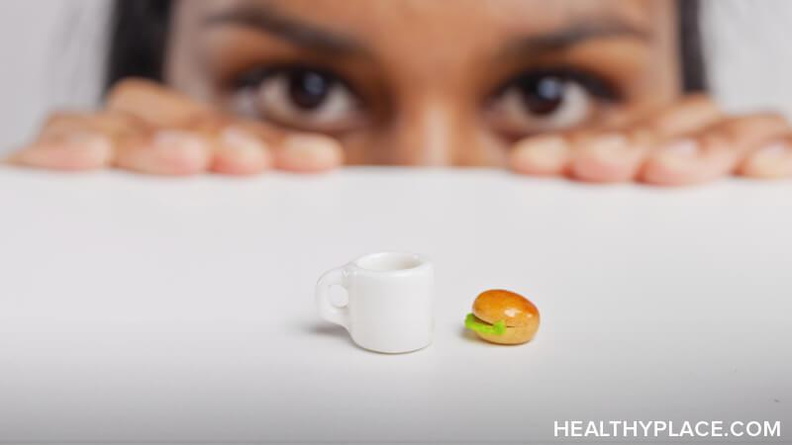A woman with bipolar disorder provides her experience of being on a locked psychiatric ward.
Personal Stories on Living with Bipolar Disorder

The Hospital
Please note: The information presented here was obtained from one of my hospitalizations at the Johns Hopkins Hospital in Baltimore Maryland. The hand outs are written by the doctors and staff of the hospital. They reflect the programs offered at Hopkins. Please keep in mind that other psychiatric wards are different. This was just my experience.
What's It Like Being In The Hospital? ~ Patient Information ~ ECT ~ Affective Disorders Program Information
I have been hospitalized more times then I want to remember. Each hospitalization is different. It varies because most of the time there are different doctors and other staff members and very different approaches. Each facility is different as well. Sometimes the programs change. I can tell you that the best place I have ever been hospitalized is Johns Hopkins Hospital in Baltimore, Maryland. It's located about 3 hours from my home. They have an excellent medical team and approach. I have been a "guest" there more times then I'd like to remember. Prior to going to Hopkins, I have been in and out of my small local area hospitals on numerous occasions. It wasn't until I went to Johns Hopkins that I started on my journey to some stability.
In my experience, it's a strange occurrence to be on a locked psychiatric ward. They tell you that the locked aspect of the ward is for safety purposes. It's odd not to be able to come and go but when one is in a critical state, I suppose it is safe to be "locked in." Each hospital has its own set of rules and expectations of the patient. They are some what similar in my experience. When you arrive you are evaluated by a nurse and then the doctor. They ask a series of questions regarding your affect. At Johns Hopkins, they give you what's called a "mini mental" exam. It's a series of questions designed to see how you function and what your memory capacity is at the time. The psychiatrist will evaluate you and then give you a physical examination. When I was at Johns Hopkins last July, the exam with the doctors was about 90 minutes. They have a "team" approach at the hospital.
The team is made up of an attending doc who is the primary on the case, and an resident doc who does most of the work and sometimes a medical student. They do rounds in the morning to assess how you are doing. The rooms are comfortable and the baths are shared by two rooms. They have private and semi-private rooms. Fortunately, I was able to get a private room. I was glad of that. The daily routine consists of educational groups, support groups, occupational therapy, relaxation therapy and gym. Not all hospitals offer these programs. Twice a day you meet with your assigned nurse to discuss how you're feeling. This gives the staff an opportunity to write down your progress so that the team can review your status each day. The majority of the nurses at Johns Hopkins were excellent and very comforting. Meals are served three times a day. One is allowed to select meals from a provided menu. The food was pretty decent and the selections were adequate.
I usually end up in the hospital because I am suffering from very severe depression or mixed states. I had an excellent and very skilled set of doctors thankfully. After my assessment, the team put together a proposal for me that I was not comfortable with however. They suggested ECT for me which threw me completely. Because of the nature and duration of my depression, they felt that ECT would help break the cycle. I had been in bed for months on end with no hope in site and finally I developed a plan to take my life. I was a wreck when I went into Johns Hopkins. After four days of careful consideration, I decided to ask what plan "B" was. My doctors had examined my lengthy records and decided that I had not had a long enough trial of Lithium. Thus they decided to put my back on that drug. They felt I needed two mood stabilizers and I was already taking Depakote. I went through days getting my blood drawn to check my levels and suffered some side effects to boot. However, I decided I wanted to give this a fair chance. So I went through the daily routine each day in the hopes I would start to feel better soon. Just a note about ECT. I did see some improvements in some of the patients who were undergoing ECT. It just wasn't for me at the time. (Update: I no longer take Depakote (Divalproex). I'm on Lamictal (Lamotrigine) and Lithium Carbonate (Eskalith) now).
The first and second days being hospitalized are the hardest. I cried and cried after my husband had to leave. It was very difficult on me. I felt totally isolated and all alone. My depression seemed to get a bit worse because of these intense feelings. You feel like you're under a microscope with all the docs and nurses watching you, not to mention the other patients. Eventually, you make friends on a very deep level. It's easy to relate to someone who shares a similar illness. At first you're very quiet at the groups and don't want to talk or look at anyone. Then in due time you warm up a bit. It becomes easier to look people in the eye instead of away. It also becomes easier to speak if you choose to. The main thing to remember is that your there to get stabilized. That should be your main goal. It takes a lot of work to get there, however.
Each day I awoke around 7 AM and literally forced myself to shower at least every other day. That was really hard because I was not showering properly at home. I would try eat breakfast like a good camper even though I didn't have much of an appetite. I went to most of the groups as it was expected of me. I tried my best to do what was asked of me, but sometimes I skipped going to the gym and relaxation group because I just wasn't up to it. I would take naps on occasion even though they request that you stay out of your room for the day. Occupational therapy allows you to work on arts and crafts and other things. That group seemed the most enjoyable. They requested that I do an extra task and cook a meal because I was not going to the grocery store or cooking at home. They took me to the grocery store, well actually we walked, and I purchased what was needed for me to cook lunch. Making the lunch seemed rather foreign to me since I hadn't cooked anything in such a long time. It took me a while to get going, but once I did everything turned out fine. I worked the program as best as I could even though it was tremendously difficult. When your so depressed you can't see straight, it's really hard to participate. I fought my feelings to surrender to my gloom on a daily basis.
While I was in the hospital, my mood was not stable. My doctors gave me a scale to measure my moods on from 1-10, 1 being the lowest, 10 being the highest. My moods would fluctuate several times a day. I was never hypo manic, however. For example, my mood would climb in very small increments usually between a 1 and 3. I was very hopeful when my mood would get to a 3 thinking the drugs were working. Then I get slammed back down again. It was very upsetting to say the least. I was in tears a lot of the time. The whole experience was very difficult. I also suffered agitated depression which is very uncomfortable.
Being hospitalized is not glamorous. They expect a lot out of you in an attempt to help you I suppose. You are exposed to all walks of people with varying degrees of illnesses. You are expected to follow the schedule, eat, and participate even if you don't feel like it. On Meyer 4 where I was, there are two groups of illnesses which are affective disorders and eating disorders. The unit has 22 beds and it's very difficult to get on this unit. They always have a waiting list. I had to wait a day or two before they would take me. This was really hard on my family because of the degree of my suicidal state. They watched over me very carefully until I was able to be admitted. Once there, I felt extremely sad, especially when my husband had to leave. He was facing a 3 hour drive home. He visited me during visiting hours as much as possible. The staff was very nice and allowed him to come a bit early and stay a bit late sometimes as long as it didn't interfere with the groups. They do this for people who live far away.
Gradually after almost a month, they discharged me. The Lithium was not an instant success. My doctors explained that it could take several months for the lithium to reach optimum benefits. When I left the hospital, I was still depressed however it wasn't as seriously pronounced and my death wish had gone. I look back on this experience and am thankful for the excellent and knowledgeable doctors that I had. The staff treated me very well for the most part. I fired my old psychiatrist and went with another Hopkins trained doctor. He's excellent and has written four books to boot. I feel very fortunate to have him. Today, I'm doing much better and I feel the Lithium and other drugs I'm taking are starting to improve my state. It was very hard to be hospitalized for that long of a period of time, but I managed and got through it!
If you wish, you can click the links below to see what patient hand-outs and things they give you when you arrive. It will give you good insight as to what it's like to be in the hospital. Thank you.
This is a patient information hand-out I received upon my arrival at Johns Hopkins.
WELCOME TO MEYER 4
Meyer 4 is one of the four separate Inpatient Units of the Henry Phipps Psychiatric Service. It is a specialty unit for affective disorders and eating disorders. The unit functions on the basis of an interdisciplinary team approach working together with you and your family in implementing your individual treatment plan. The members of your treatment team working under the direction of an attending physician are:
| Attending physician: | _____________________________ |
| Nurse Manager: | _____________________________ |
| Resident Physician: | _____________________________ |
| Social Worker | _____________________________ |
| Primary Nurse: | _____________________________ |
| Associate Nurse: | _____________________________ |
| Occupational Therapist: | _____________________________ |
| Nutritionist: | _____________________________ |
Telephones: Nurses Station:
| Patient Pay Phones: | _____________________________ |
| Front DayArea: | _____________________________ |
| Patients Hallway: | _____________________________ |
Patient phones are limited in use to the hours of 8AM-11PM. Please limit calls to 15 minutes at a time in consideration of others.
VISITING HOURS:
Monday/Wednesday/Friday - 6PM-7PM
Tuesday/Thursday: - 6PM-8PM
SaturdaylSunday/Holidays: - 12PM-8PM
Children and infants must be under the supervision of parents or guardians. Parents or guardians of patients under the age of 18 years must provide the staff with a written list of approved visitors.
MEDICATIONS: On admission, medications will be ordered by your Meyer 4 physicians. Please arrange to send home any medications (prescribed or over-the-counter medications) brought with you. All medications will be administered to you on a daily basis by nursing staff. No medications are allowed to be kept in your room, (unless an exceptional doctor's order is given. Please take note of the times they are ordered. It is important to keep them on schedule. We encourage you to learn all you can from your physicians and nurses about your medications.
VALUABLES: Please send all valuables home. If not possible, hospital security will place your valuables in the Admitting Office safe and give you a receipt for retrieval. We advise keeping a small amount of case to use for laundry, magazines, sundries, etc. You can purchase items in the gift shop located on the first floor of the hospital.
ROOMS: On admission, you will be assigned a single or a double room. There are times when we must change patient rooms because of your treatment requirements or those of another patient
NOTE: Male and female patients are not allowed to visit in the same room.
TEAM ROUNDS AND INDIVIDUAL THERAPY:Your physicians will make walking rounds on the unit every morning. Therefore, you should not leave the unit until after your physicians have seen you. This is an essential time to discuss your problems and treatment plan on a daily basis.
For individual therapy, your assigned resident physician will arrange set times with you.
Your primary and associate nurses will individually plan your care with you and take a special interest in assisting you with your treatment goals. When they are not on duty, another nurse will be assigned. You and your nurse arrange an appropriate time to meet for an individual session.
The social worker is concerned with understanding you in relation to your family and your environment. Sessions can be arranged for guidance in utilizing community resources, discharge planning and family counseling.
The nutritionist is concerned with your dietary needs. Sessions can be arranged to guide you individually, especially if you have an Eating Disorder.
GROUP THERAPY: Much of your psychotherapy is conducted in the group setting. The occupational therapist will discuss with you which groups you are assigned, and you will receive a schedule to follow. The nursing staff also conducts teaching and support groups. Attendance and participation are expected at the daily groups (Monday-Friday), and in community meetings (Monday and Friday evenings). We encourage you to learn all you can, ask questions and appropriately discuss problems. Educational material about your illness will be provided in the form of videos, slides, books, articles and other printed handouts.
RESEARCH: The Johns Hopkins Hospital is proud of its contributions to the discovery of causes and treatments of disease. The advances in psychiatry are the results of research projects involving clinicians and their patients.
We hope you will consider taking part in research projects presented to you. However, you have no obligation to take part in them.
GETTING UP IN THE MORNING AND BEDTIME:All patients are expected to be up no later than 9:00 a.m., and dressed in appropriate street clothes. Patients are expected to retire to their rooms at the latest by 12 midnight (during the week), and by 1:00 a.m. (on weekends). The night staff checks each patient's room every half hour during the night for your safety. Please alert the staff if you have difficulty sleeping.
MEALS: Three meals a day (and a snack if appropriate) will be brought to the unit Patients are expected to eat int the front day area of the unit. Your name will be on your menu on your tray. Blank menus will be brought each evening to the unit for your selection. Note that newly admitted patients who have Eating Disorders do not receive menus but will receive special instructions and be provided with an Eating Disorder
Protocol booklet.
MealTimes: Breakfast 8 am-9 am
Lunchl2 pm-l pm
Supper5 pm -6 pm
SAFETY FOR ALL PATIENTS: All packages brought to the unit must be checked at the nurses station. Sharps such as, (razors, scissors, knives, etc.) will be taken from you and secured at the nurses station. Potentially harmful chemicals (such as, nail polish remover), will be removed and secured Visitors may not give any type of medication to patients. Visitors may notprovide food (including candy and gum) to patients who have Eating Disorders because their diet is strictly and therapeutically supervised. Alcoholic beverages and illicit drugs are strictly prohibited on the unit Please note: For reasons of patient safety, the treatment team will decide to keep wilt doors locked.
T.L.O.A.'s: or Therapeutic Leave of Absence. A physician's order, with the approval of the treatment team, as required. First fill out a request form; talk it over with your primary or associate nurse; and obtain comments and signatures from either of them. The request will then be discussed and a decision will be made by your treatment team.
T.L.O.A's are generally granted toward the end of hospital stay. The main purpose of a T.L.O.A. is to assess how patients function and communicate with their families and loved ones, (in the home setting usually). This is preparatory to discharge. It is vital that patients, families, and significant others inform the staff about the activities, and interactions involved on T.L.O.A
T. L.O.A's are usually granted for Saturday and Sunday in time spans of 4-8 hours (never overnight). Overnight and too frequent day passes are not usually approved by health insurance. T. L.O.A.'s should not interfere with groups.
ON CAMPUS WALKS:Means that you may walk inside the hospital and the sidewalk encircling the building; not woss streets. These are usually permitted with staff, or family (if considered therapeutic); and are time-limited. They are not to interfere with scheduled groups. Sometimes patients are allowed time-limited on campus walks alone (if therapeutic).
NOTE: This is an inner city area wherein you should exercise caution, more so than in a rural or suburban area. Patients under the age of 18 years are required to have written permission from parents or guardians stating approval for on campus walks alone. All patients leaving the unit must sign out at the nurses station.
UNIT FACULTIES: The laundry room is located in the patient's hallway. Itis equipped with a washer and dryer.
The day area, in the front of the unit, contains a kitchen as well as a dining area, a lounge area with a television, VCR, books, games, and plants.
The back activity room has a lounge with a television, books, games, and a ping-pang table.
We hope you'll be able to use and enjoy these facilities, and please remember that they are shared with as many as 22 patients at a time. Noise level should be kept down. Each person should be considerate of others. We encourage self responsibility for keeping rooms and unit facilities in order.
We encourage you to ask questions. We will do our best to keep you informed and to assist you in getting adapted to the community of Meyer 4.
I was given this hand out explaining ECT while hospitalized at Johns Hopkins.
ECT Procedure
ECT involves a series of treatments. For each treatment, you will be brought to a specially equipped room in this hospital. The treatments are usually given in the morning, before breakfast. Because the treatments involve general anesthesia, you will have had nothing to drink or eat for at least 6 hours before each treatment, unless special orders have been written by the doctor to receive medicines with a sip of water. An intravenous line (IV) is placed in your arm so that medicines that are part of the procedure can be given. One of these is an anesthetic drug that will quickly put you to sleep. When you are asleep, you are given a second drug that relaxes your muscles. Because you are asleep, you do not experience pain or discomfort during the procedure. You do not feel the electrical current and when you wake up you have no memory of the treatment.
To prepare for the treatments, monitoring sensors are placed on your head and chest. Blood pressure cuffs are placed on one arm and one ankle. This enables the physician to monitor your brain waves, heart, and blood pressure. These recordings involve no pain or discomfort.
After you are asleep, a small, carefully controlled amount of electricity is passed between two electrodes that have been placed on your head. Depending on where the electrodes are placed, you may receive either bilateral ECT or unilateral ECT. In bilateral ECT, one electrode is placed on the left side of the head, the other on the right side. When the current is passed, a generalized seizure is produced in the brain. Because you will be given a medication to relax your muscles, muscular contractions in your body that would ordinarily accompany a seizure will be considerably softened. You will be given oxygen to breathe. The seizure will last for approximately one minute.
Within a few minutes, the anesthetic drug will wear off an you will awaken.
You will be brought to a recovery room, where you will be observed unfit you are ready to leave the ECT area and return to the unit.
Frequently asked questions about ECT...
1.Will the procedure hurt?
No. Prior to getting ECT you will receive a muscle relaxant to prevent muscle strain from the seizure and general anesthesia so no pain is felt.
2.Why has my doctor recommended ECT for me?
ECT is recommended for patients will drug resistant affective disorders and patients who are acutely suicidal and at high risk of harming themselves.
3.How effective is ECT?
ECT is proven to be effective in about 80% of people receiving it. This is more promising than most anti-depressants.
4.Is it dangerous? And how do you know if it is safe for me?
The risks of ECT are about equal to that of minor surgery with general anesthesia. About I death occurs in 10,000 patients receiving ECT. The procedure itself is administered by an experienced team of clinicians and is carefully monitored. Many
pre-ECT tests will be done to make sure ECT is safe for you. This includes blood tests, general physical, mental status exam, and an anesthesia consult. Chest x-rays and an ECG are done for older patients.
5.Doesn't ECT make you lose your memory?
ECT causes short term memory disturbances. Long term memory is generally not affected. You may forget events surrounding the procedure and even things that happen a few days before and in between treatments. It will be difficult to remember things. This clears up in a few weeks after treatments with a return to pre-treatment functioning in 3-6 months.
6.Does it cause brain damage?
No. Research shows that ECT does not cause any cellular or neurological changes in your brain.
7.What other side effects might I experience?
Along with memory disturbances, you may experience confusion, muscle soreness, headache, and nausea. Inform your doctor or nurse if you experience any of these.
8.How many ECT treatments will I need?
A series of 6-12 treatments is recommended for the greatest effect. Your doctor will decide how many are best for you.
9.Why can't I eat or drink before the treatment?
As with a surgical procedure you should have nothing in your stomach so as to prevent anything from coming up and choking you.
10.How long does the procedure take?
The procedure takes about one hour from the time you leave the unit to the time you return. The seizure itself will only last 20-90 seconds. The rest of the time is for preparation for and recovery from the procedure.
11.When will I notice improvements from ECT?
Most people will notice improvements in their symptoms in about one to two weeks
Information Obtained From The Johns Hopkins Hospital, Baltimore, Maryland.
This was given to me while I was hospitalized at Johns Hopkins in July 2000.
AFFECTIVE DISORDERS PROGRAM
Affective disorders are illnesses that affect the way people feel, think and act. They may cause patients to develop unhealthy behaviors that may easily become habits. One of the goals of the Phipps Clinic is to encourage the return of healthy behaviors that will support that patient after returning home. Our structured program supports the medical treatment that patients receive and enhances treatment outcomes. We encourage patients to participate fully in the Affective Disorder Program and to share the responsibility for their treatment by following these guidelines:
Communication:
Be informed about your illness and about your treatment. We encourage full participation in treatment and discharge planning. Discuss your concerns and your treatment plan on a daily basis with the treatment team. If your family has specific concerns they should contact the social worker.
Making everyone feel comfortable is important. Be polite and respectful in interactions with other patients, staff and visitors.
Groups:
Groups are an essential part of the program. We offer several types of groups - education, support and occupational therapy groups. These groups are designed to help you learn more about your illness and develop skills to help you cope with your illness. They also give us important information that help us assess your progress; so it is important to attend all your scheduled groups. We ask that you use on campus privileges only during non-group times and ask visitors, including any out-of-town visitors, to come during non-group times.
You may also be given assignments designed to address your treatment goals. It is important to complete your assignments.
Medications:
You will receive education about your medications. Try to learn as much as possible about your medications and to get into the habit of taking medications at the regularly scheduled times. You are encouraged to approach your nurse for your medications on time. This will help establish the health habit of taking responsibility for taking medication at specific times while you are still in the supportive surroundings of the hospital.
Activities of Daily Living:
The symptoms of the illness may lead patients with affective disorder to neglect activities of daily living, e.g., getting out of bed, maintaining personal hygiene, eating meals, etc., which can lead to worsening of the depressions and other complications. We encourage patients to maintain appropriate activities of daily living by maintaining proper hygiene, grooming and appropriate dress. Please ask your nurse if you will need assistance.
Physical Activity:
It is also important to keep active by getting some physical activity each day, in the gym or on walks. We encourage you to stay out of your room at least 6 hours a day and not isolate yourself from others.
Sleep Habits:
We encourage you to be up and out of bed by 8:30 AM. To promote proper sleep hygiene, we recommend that patients retire to their rooms by 12:00 midnight during the week, and by 1:00 AM on weekends. Adolescents are to be in bed by 11:00 PM on weekdays and 12:00 midnight on weekends.
Nutrition:
We will be assessing your food and fluid intake to see if you are maintaining proper nutrition. Meals should be eaten in the dining area. To facilitate getting the meal that you ordered, please complete your menus for the next day by 1:00 PM.
Privileges:
Patient safety is our highest priority. For this reason, if we think a patient is at risk for harming himself or herself, we have the patient stay on the inpatient unit on observation until he/she is safe. Once a patient is safe to go off the unit the first privilege is to go on campus with staff for tests and groups.
The next privilege level is to go on campus with family, then later in the hospitalization, on campus alone for periods of time.
Towards the end of the hospitalization, the patient may be given a therapeutic leave of absence (TLOA) to assess one's mood and level of functioning off the unit.
You are strongly encouraged to follow these guidelines which we have found to be helpful in our treatment of many patients with affective disorders. Participation in the entire Affective Disorder Program is considered when the Treatment Team determines what privilege level is appropriate for you.
next: Juliet: Family and Bipolar Disorder
~ bipolar disorder library
~ all bipolar disorder articles
 Adjusting both diet and nutrition may help some people with mental illnesses manage their symptoms and promote recovery. For example, research suggests that eliminating milk and wheat products can reduce the severity of symptoms for some people who have schizophrenia and some children with autism. Similarly, some holistic/natural physicians use herbal treatments, B-complex vitamins, riboflavin, magnesium, and thiamine to treat anxiety, autism, depression, drug-induced psychoses, and hyperactivity.
Adjusting both diet and nutrition may help some people with mental illnesses manage their symptoms and promote recovery. For example, research suggests that eliminating milk and wheat products can reduce the severity of symptoms for some people who have schizophrenia and some children with autism. Similarly, some holistic/natural physicians use herbal treatments, B-complex vitamins, riboflavin, magnesium, and thiamine to treat anxiety, autism, depression, drug-induced psychoses, and hyperactivity.
 Many people from different cultures see
Many people from different cultures see 
 Practice taking people seriously for what they say, feel, and do, not for how slender or "well put together" they appear.
Practice taking people seriously for what they say, feel, and do, not for how slender or "well put together" they appear. The United States is in the midst of an entrepreneurial renaissance. People are literally waking up to the idea that they can work for themselves and make a lot of money doing it. And, while there are as many types of entrepreneurs as there are businesses, most entrepreneurs share some common traits. They tend to be visionaries. People who go into business for themselves tend to be risk takers. After almost a decade of coaching entrepreneurs, it has also been my observation that a majority of all entrepreneurs have Attention Deficit Hyperactivity Disorder, or AD/HD.
The United States is in the midst of an entrepreneurial renaissance. People are literally waking up to the idea that they can work for themselves and make a lot of money doing it. And, while there are as many types of entrepreneurs as there are businesses, most entrepreneurs share some common traits. They tend to be visionaries. People who go into business for themselves tend to be risk takers. After almost a decade of coaching entrepreneurs, it has also been my observation that a majority of all entrepreneurs have Attention Deficit Hyperactivity Disorder, or AD/HD. The hand of the past pushes a depressive toward depression. But it is usually the jab of a present event that triggers the pain - say, loss of your job, or being jilted by your lover. It is that contemporary happening that darkly dominates your thoughts when you are depressed. To get undepressed you must reconstitute your current mode of thinking so you can get rid of the black thoughts. Again - yes, the past causes you to be what you are now. But the main avenue out of your present predicament is by reconstructing the present rather than dealing with the past.
The hand of the past pushes a depressive toward depression. But it is usually the jab of a present event that triggers the pain - say, loss of your job, or being jilted by your lover. It is that contemporary happening that darkly dominates your thoughts when you are depressed. To get undepressed you must reconstitute your current mode of thinking so you can get rid of the black thoughts. Again - yes, the past causes you to be what you are now. But the main avenue out of your present predicament is by reconstructing the present rather than dealing with the past.



 Relapses - they can and will happen during recovery from an eating disorder. I want to say right now that if you are suffering from an eating disorder and making a hard attempt at getting better, that sooner or later you will encounter a relapse (if you haven't already). The relapse could last a day, a week, a month, but a relapse is not an uncommon thing to have happen during recovery from an eating disorder. This does not mean that you shouldn't try at all to recover because you think, "Well, I'm just going to relapse anyway, so what's the point?"
Relapses - they can and will happen during recovery from an eating disorder. I want to say right now that if you are suffering from an eating disorder and making a hard attempt at getting better, that sooner or later you will encounter a relapse (if you haven't already). The relapse could last a day, a week, a month, but a relapse is not an uncommon thing to have happen during recovery from an eating disorder. This does not mean that you shouldn't try at all to recover because you think, "Well, I'm just going to relapse anyway, so what's the point?" Many people with bulimia maintain a nearly normal weight. Though they appear healthy and successful--"perfectionists" at whatever they do--in reality, they have low self-esteem and are often depressed. They may exhibit other compulsive behaviors. For example, one physician reports that a third of his bulimia patients regularly engage in shoplifting and that a quarter of the patients have suffered from alcohol abuse or addiction at some point in their lives.
Many people with bulimia maintain a nearly normal weight. Though they appear healthy and successful--"perfectionists" at whatever they do--in reality, they have low self-esteem and are often depressed. They may exhibit other compulsive behaviors. For example, one physician reports that a third of his bulimia patients regularly engage in shoplifting and that a quarter of the patients have suffered from alcohol abuse or addiction at some point in their lives.